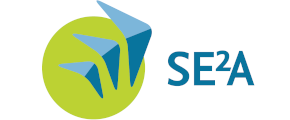
Project B4-2 addresses, in close collaboration with B4.1, the simulation-based design of a skin heat exchanger. The heat rejection system serves as a prototype for unexplored design configurations in new electric aircraft, which covers multiple and coupled disciplines as well as complex physics, data structures and models.
We present new ideas for coupling multi-disciplinary data on different fidelity levels and for analysing the propagation of errors and uncertainties in coupled problems. Moreover, semantic knowledge representations will be used to impose a semantic structure on the data and the models, which enables a more principled coupling. Further, we will take first steps to explicitly make knowledge design through advanced knowledge representations and explainable AI, which is important in view of the growing modeling complexity and which shall assist designers in the future.
Finding more efficient solutions of complex multidiscipline problems requires not only coupling different physical aspects into one system, but as well different models, solvers and even teams or departments. To enable the use of well-suited, individual, solution techniques for each specific discipline and fidelity, a partitioned solution approach is mandatory, which solves the coupled problem by dedicated coupling algorithms and mappings between the individual solvers. This stands in contrast to so-called monolithic solution approaches where the whole multidisciplinary coupled problem is formulated as a single large coupled discrete system. Essentially, the monolithic approach is often seen as more robust but at the same time unable to deal with a multi-code environment, which is the standard case in industry-level multidisciplinary analysis and design workflows. This flexibility of realizing mixed-fidelity and coupled physics simulations by various solvers requires a consistent formulation of the coupling conditions and the orchestration of the overall simulation workflow with a so-called geometry master model and mapping operators between the diverse simulation tools are key requirements. The master model is achieved here by a B-Rep CAD representation, with multiple coupled and trimmed NURBS patches as shape description. Moreover, the different methods for CAD-integrated simulation are a suitable methodological basis, amongst them the so-called Isogeometric Analysis (IGA) with its extension to real-world B-Rep models of complex geometries, the Isogeometric B-Rep Analysis (IBRA).
The project studies the possibility of realizing a co-simulation framework, which enables efficient and simple cooperation solution, and where various teams can efficiently integrate their models and codes to solve aforementioned complex problems.
Uncertainty quantification (UQ) is of particular importance in multidisciplinary systems. Different scales and coupling effects between disciplines often amplify existing uncertainties. Furthermore, the complexity makes it difficult for developers to correctly assess the significance of results based on experience alone.
Multi-fidelity approaches are particularly suitable for uncertainty quantification in multiphysics systems. Since high-resolution simulations in aviation are often very computationally intensive, low-cost surrogate models are constructed and used simultaneously with the full order models. Subsequently, the variable fidelity models of the sub-disciplines are coupled in a modular way for uncertainty analysis.
During development, knowledge might be lost between projects, even between iterations within the same project. Engineers especially can benefit from the fact that human knowledge can be represented and stored with semantic technologies, specifically knowledge graphs and ontologies. These can list an individual airplane that might carry you on your next flight, as well as its model, its design series and the development behind that. Simultaniously, this can extend down to each single screw and rivet used, both again in class that an engineer requires for this task and individual entity that a mechanic places to fullfill it. However, the current status quo in engineering knowledge representation lacks behind it's potential in the usage of state-of-the-art semantic technologies and the interoperability they provide.
With this project, we aim to utilize this potential by integrating knowledge graphs into the KRATOS-based design workflow. Knowledge required and produced by simulations in multi-fidelity multidisciplinary design steps can be seamingly formalised and alligned to be interoperable at all times. We increase the efficiency of knowledge transfer between systems and projects by formalising the knowledge assisted by tools and their access to large-scale knowledge graphs like WikiData. By removing the need for redundant knowledge specification, founding our progress on a literature survey on prior knowledge and it's representation in aerospace enginnering, we are heading to more sustainable knowledge flow, wherin each contributor simultaniously benefits from and beneficiates to the grander knowledge base.
Prof. Dr.-Ing. Roland Wüchner
Institut für Statik und Dynamik, TU Braunschweig
r.wüchner@tu-braunschweig.de
Prof. Dr.-Ing. Ulrich Römer
Institut für Akustik und Dynamik, TU Braunschweig
u.roemer@tu-braunschweig.de
Prof. Dr. Sören Auer
TIB, L3S Research Center, Leibniz Universität Hannover
soeren.auer@tib.eu